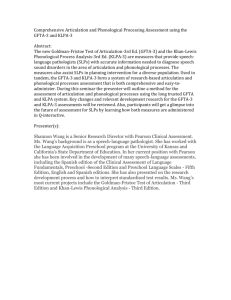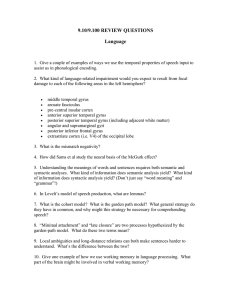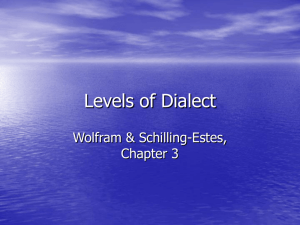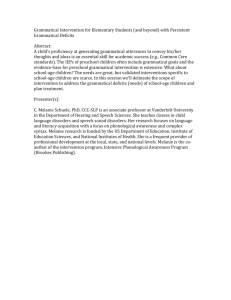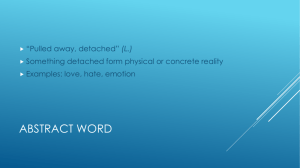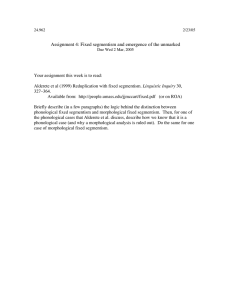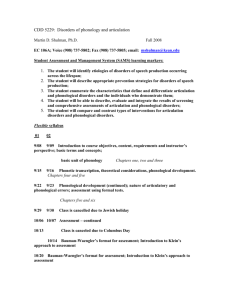Document 13670982
advertisement
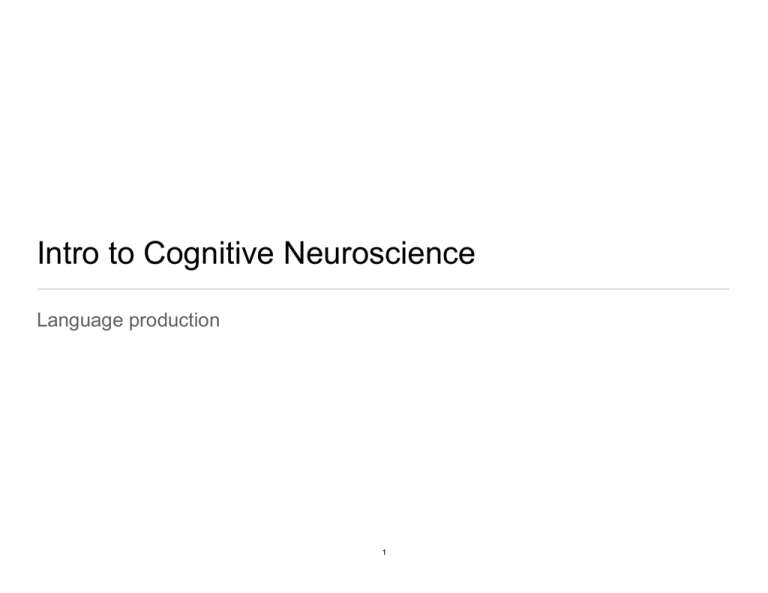
Intro to Cognitive Neuroscience Language production 1 But first, that paper • Carlyon, R. (2004). How the brain separates sounds. Trends in Cognitive •Science, 8 (10), p 465 - 471. 2 Language production • Idea to be conveyed (non-linguistic) Message Grammatical encoding Phonological encoding Articulation • Selecting words • Developing sentence structure • Phonological representation of sentence is developed. • Actual production of speech 3 Be a neuroscientist! Message • Hypothesis: Language production involves distinct phases. • Your mission: Design an experiment that would test this hypothesis. Grammatical encoding Phonological encoding • What’s the IV? The DV? How will you define these such that you can measure them? • What results would support your hypothesis? Articulation 4 Language centers • Marsel Meslaum - language circuits in the brain. • Rote language production uses just motor and pre-motor areas. • Hearing words activates primary auditory cortex, then unimodal association areas. 5 Image courtesy of Bruno Dubuc, The Brain From Top to Bottom Language processing at different levels • PET scan (subtractive) of participants doing different language tasks. Image removed due to copyright issues. To see an image of a PET scan of participants doing different language tasks, click on the following link. http://plato.stanford.edu/entries/innateness-language/PosnerRaichle.jpg 6 Errors in speech production • Exchange errors - when two elements of a sentence are transposed. • Word-exchange error: I wrote a mother to my letter. • Sound-exchange error (aka spoonerism): You have hissed all my mystery lectures! The Capitol Steps, a political humor group, has produced segments called “Lirty Dies” that use exchange errors. Click on the link to see examples. http://www.capsteps.com/lirty/ 7 Grammatical encoding • Word selection requires relating semantic information from the message to individual words. • Occasional errors that are a blend of two different words. • How can you study how sentence syntax develops? 8 Grammatical encoding • Language production study disguised as a memory experiment. • Bock hypothesized that some words are quicker to choose, and a sentence structure is created that puts those words first. • Subjects were shown pictures, instructed to say a sentence out loud about each picture. • Accessibility of words was modified by priming. 9 Five-minute writing • Write a paragraph summarizing a main idea from the reading. 10 Phonological encoding • Speaker must retrieve phonological information about each word. • Tip-of-the-tongue states occur when the connection between the semantic and phonological representation for a word is blocked. • TOT states are more common for uncommon words. • Severe TOT states can arise from brain injury. 11 Phonological and grammatical interactions • Does information from phonological levels influence grammatical levels? • Word exchange errors occur more often in words with similar phonemes. 12 Articulation • Articulation is basically a matter of very fine motor control. • A disproportionately large amount of motor cortex is devoted to the lips, jaw, and tongue. Image courtesy of Bruno Dubuc, The Brain From Top to Bottom 13 Articulation • Primary motor cortex (M1) controls fine motor abilities. • Premotor area sets up sequences of actions, especially in response to perceptual information. • Supplementary motor area is involved in action plans. 14 Writing • Written language tends to vary from spoken language. • Often produced in isolation. • More complex syntax. • Opportunities for revision after production. 15 Speaking of writing... • Essay question for this week is changed from that on the syllabus. • Explain how context is involved in at least two aspects of language processing. You could consider speech perception, ambiguous words and sentences, discourse-level organization, evidence from speech errors, or other aspects of language. 16 MIT OpenCourseWare http://ocw.mit.edu Introduction to Cognitive Neuroscience Summer 2008 For information about citing these materials or our Terms of Use, visit: http://ocw.mit.edu/terms.
